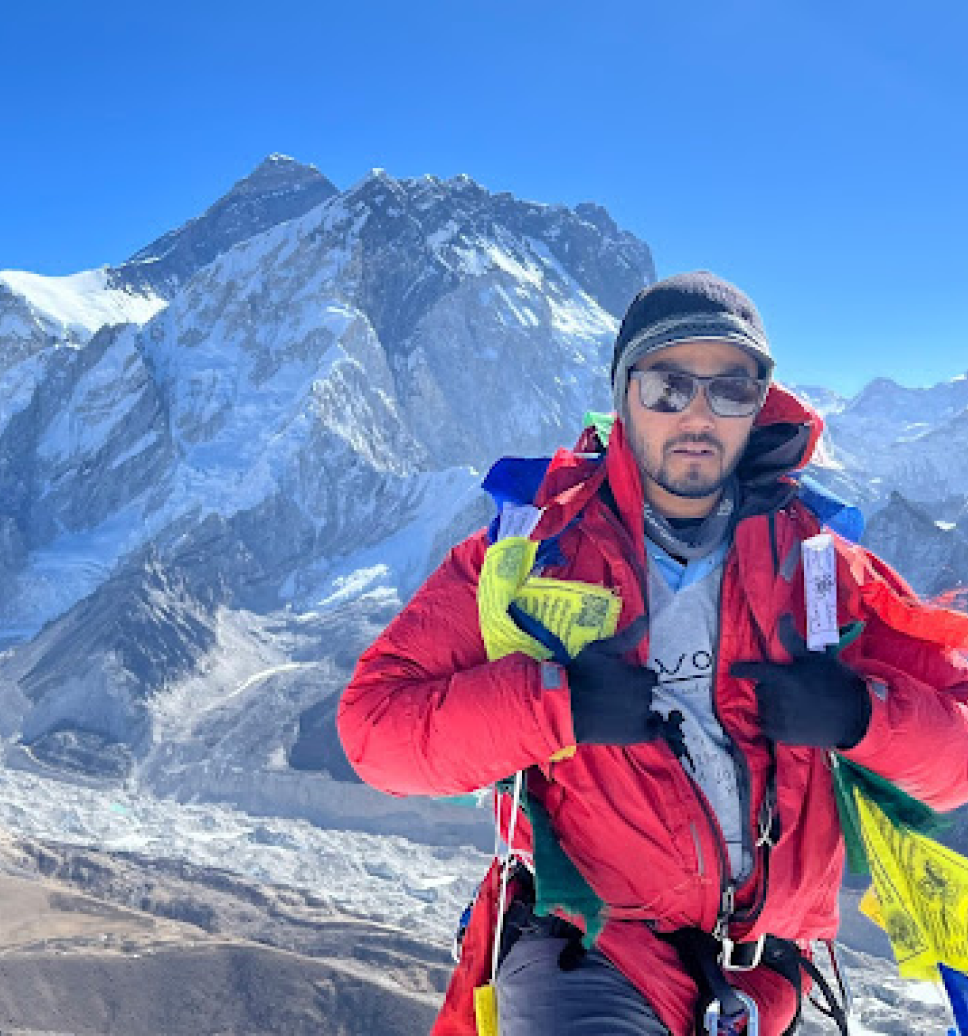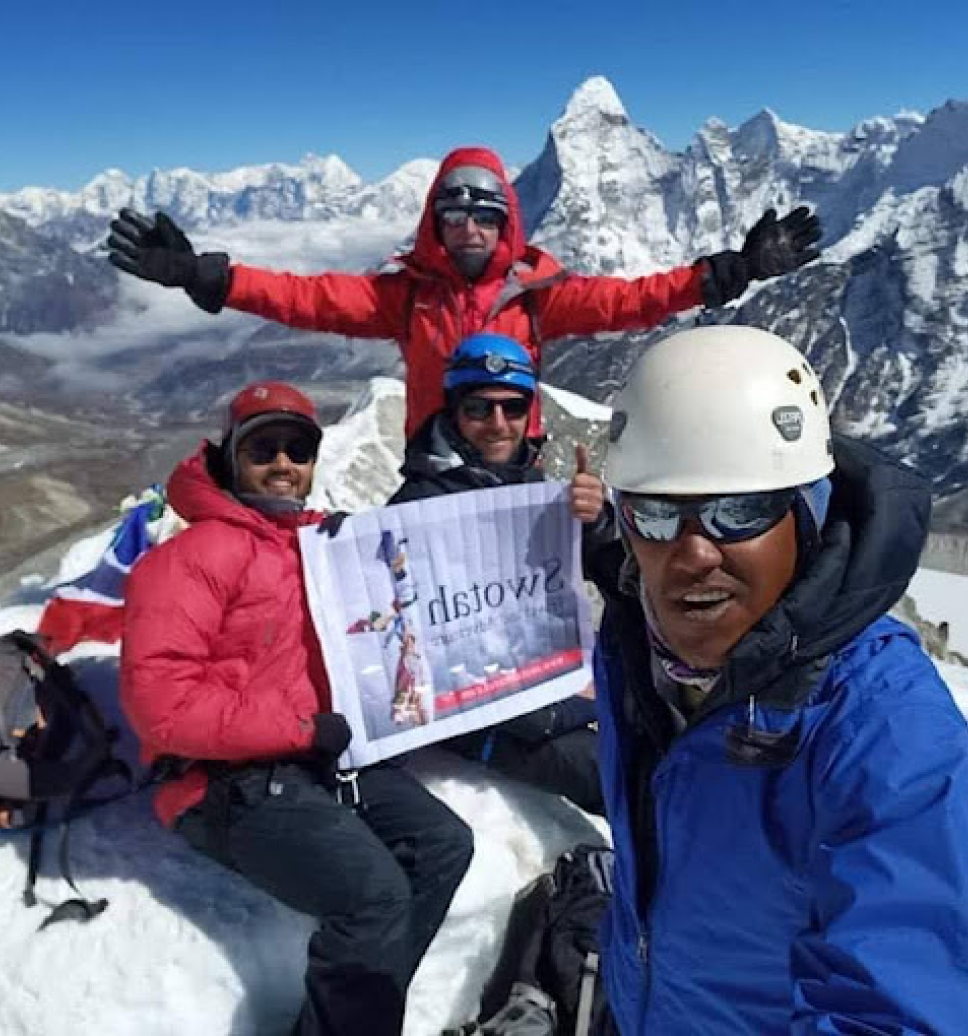GUARANTEED DEPARTURES
Check upcoming trip dates, availability & prices. If you can't see dates that suite you, contact us we will do our best to assist you.
| GUARANTEED DEPARTURES | PRICE | AVAILABILITY | |
| Jan 5, 2026 - Jan 7, 2026 | $300 | High | |
| Feb 9, 2026 - Feb 11, 2026 | $300 | High | |
| Feb 16, 2026 - Feb 18, 2026 | $300 | High | |
| Mar 2, 2026 - Mar 4, 2026 | $300 | High | |
| Mar 13, 2026 - Mar 16, 2026 | $400 | High |
Trek Highlights
- A closer encounter with the seventh-highest peak Dhaulagiri,( 8,167 meters (26,795 feet), and tenth- highest peak Annapurna I( 8,091 meters (26,545 feet)
- Ghorepani has a captivating and expansive rhododendron forest rich in flora and fauna in the Annapurna region of Nepal.
- The beautiful 200-year-old village of Ghandruk feels like an open-air, thanks to the dedicated locals, Gurung and Magars.
- As trekkers, venture through the Annapurna Conservation Area, Nepal's largest and first protected area. Catching a glimpse of rare and elusive species like Himalayan Blue Poppy, Himalayan Edelweiss, Cobra Lily Red Panda , and Himalayan Tahr won't be surprising won't be surprising and uncommon.

The worth-climbing trek, Ghorepani Poon Hill trek, stands out as one of the shortest, safest and most suitable for all experience levels. This journey is not only about reaching the Poon Hill vantage point, but the real essence lies in the lush, dense rhododendron forests, culturally rich villages, vibrant hospitality of villagers and the ever-present backdrop of the Annapurna and Dhaulagiri range.
Photo Gallery
Dive into our gallery to get a glimpse of the awe-inspiring vistas waiting for you on our guided treks across stunning landscapes.
Brief Itinerary
Day
1
Pokhara to Ghandruk and trek to Tadapani ( via Nayapul) (2630 meters)
Day
2
Tadapani to Ghorepani (2874 meters)
Day
3
Ghorepani to Poohill to Ulleri (3,210 meters)
Day
4
Ulleri to Nayapul to Pokhara (822 meters)
Comprehensive Trek Guide
Poonhill is named after the Pun or Poon clan from the Magar Caste of Nepal. The Magar belong to the Tibeto-Burmese ethnicity; Pun, however, has quite an unexplainable origin. The Picturesque Poonhill remarkable short trek is popular among tourists and travellers for its exquisite views of expansive snow-capped peaks and ineffable sunrise and sunset.
This short adventure offers everything that a long and arduous trek in Nepal has to offer in a relatively brief manner of time. The Poon Hill trek, otherly known as Ghorepani Trek or Ghorepani poon hill trek, lies in the lower part of the Annapurna region and a larger part of the Annapurna Circuit trek and Annapurna Base Camp trek. This famous hill station sits near Ghorepani village in the Myagdi district of Nepal. Poonhill, at an altitude of approximately 3,210 meters (10,531 feet), is just 68-69 kilometres away from Pokhara. This 4-day Poon hill trek itinerary starts and ends in Pokhara. This trek offers an immersive experience for those interested in learning the culture, lifestyle, and natural beauty of traditional Nepal with minimal physical exertion and without venturing into the wilderness.
The Ghorepani Poon Hill trek is considered to be on the borderline between an easy and a moderately complex trek. However, it is definitely more accessible than any other classic trek in Nepal. Poonhill viewpoint directly offers breathtaking views of more than 32 Himalaya peaks, especially the Annapurna and Dhaulagiri ranges.
Starting on day 1, it is a four-hour drive from Pokhara to Ghandruk via Nayapul then you will trek a 3 hour to reach Tadapani. The trek commences on day 2 from Tadapani to Ghorepani and takes about a 6-8 hour hike. The most awaited section of the trek comes on Day 3, with an early hour- or- two short hike from Ghorepani to Poonhill and back to Ghorepani. Then, the start of a 4-5 hours day trek from Ghorepani to Ulleri begins, passing through Banthanti and reaching the final destination for the day. The final day, or day 4, starts from an early morning hike from Ulleri to Hille, Birethanti, and finally reaches Nayapul after 4-5 hours, followed by a short drive from Nayapul to Pokhara.
This trek offers an immersive experience for those interested in learning the culture, lifestyle, and natural beauty of traditional Nepal with minimal physical exertion and without venturing into the wilderness.
Weather during Poonhill Trek
Spring (March to May)
Spring murmurs happiness as the blooming wildlife awakens, painting the landscape in a soothing green colour adorned with hues of nature's confetti and foothills covered in red and white rhododendrons. Spring is one of the most preferred weathers by hikers, travellers, and tourists for trekking to poon hill. The reasons are moderate temperature, clear visibility, low precipitation, and dry and stable weather. The temperature in Poonhill ranges from 10°C to 25 °C. The mornings and evenings are cooler but not uncomfortably cold and freezing.
Summer ( June to August):
Summer in Nepal is synonymous with the monsoon season, bringing frequent and heavy rainfalls, particularly in July when it often pours like cats and dogs. The Hike to Poon Hill becomes warmer and humid, needing shorts and a T-shirt along with a raincoat. The trail is usually muddy, slippery, and waterlogged, increasing the risk of landslides. Additionally, visibility is quite low due to clouds and a high level of perception. Daytime temperatures at Poon Hill range from 15°C to 30°C (59°F to 86°F), and nighttime temperature can drop to 0°C to 15°C (50°F to 59°F). However, the low crowd during this season in Poon Hill offers the feeling of having a whole place to yourself. This is not the typical and definitely ideal weather for a Nepal trek, but it can be experienced as a palette cleanser, so go for it.
Autumn ( September to November):
Autumn in Nepal is one of the best seasons and times in Nepal and is highly preferred by most travellers, trekkers and tourists heading to Poon Hill. This season, also known as the post-monsoon season, offers wonderful visibility with clear skies, making it perfect for dramatic views of Himalayan peaks. The moderate temperature, neither too hot nor too cold, however, the temperature starts to drop after the end of the Sepetember, indicating the incoming winter season. This ideal season’s weather ranges from 10°C to 20°C (50°F to 68°F) in day time and 0°C to 10°C (32°F to 50°F) in night time. Autumn in Nepal brings vibrant Nepali festivals, Dashain and Tihar, and transforms this trek into a unique cultural experience. As you hike, the fields are bursting with yellow marigolds, swings (ping) set up in every village, and colourful kites (Changa) dancing in the rhythm of excitement in the sky. The tradition of receiving red tika( mixture of rice, yoghurt and vermillion) on the forehead, along with Kamara, adds a deep cultural touch, giving trekkers a chance to connect with Nepali people and Nepal on a personal level. One of the drawbacks is that this pleasant season, with a dry and stable trail, invites too many tourists, making the trail a bit too crowded. Nonetheless, it’s a season full of joy and excitement.
Winter ( November to February ):
Winter in Nepal is generally less preferred in tourism and is considered to be the least famous season, resulting in a significant decrease in the number of visitors compared to other seasons. Even an easy trek like Poon Hill becomes strenuous and challenging due to factors such as frequent fog and lower visibility, cold temperature, snowy and slippery trails, and chances of Altitude Sickness, making it more difficult and potentially hazardous. Additonally, shorter daylight hours, unpredictable weather and a decline in temperature deter further travellers. The temperate can range from 5°C to 10°C (41°F to 50°F) in daytime, while nighttime can drop to -5°C to -10°C (23°F to 14°F).
Ghorepani Poon Hill Trek Difficulty
The Ghorepani poon hill trek is a moderate and beginner-friendly trek that is relatively easy and comfortable, but that does not mean it’s as simple as walking on a smooth, paved road in major cities. The Poon Hill trail can be steep and strenuous in some parts, requiring an average of 7 to 8 hours of walking each day. This trek is a short one, and the trek can be done in 3 or 4 days. Although this trek does not require any climbing or technical skills, prior trekking experiences and a decent fitness level can be beneficial.
Accommodation and Food
Trekkers do not need to worry about accommodation throughout the entire trek. The Ghorepani Poonhill trek is a commercialized area, yet it manages to retain its authenticity. It is quite fascinating and amusing that the people of this region have been able to conserve their culture and heritage while maintaining their tourism and hospitality businesses. Several teahouse guesthouses are available at stops ranging from budget hotels to mid-range and luxury hotels. Typical guesthouses have twin sharing beds in a room with attached toilets and sometimes communal, and all the amenities like hot and cold showers. They have included in the costs of bedding that some places charge extra for hot showers, such as in Tadapani.
Swotah provides a heavy breakfast and a main course for lunch and dinner each day if you choose Poon Hill with us. The food on the Poon Hill trek is hygienic and tasty, with a diverse menu that includes both local and Western cuisines. Most of the teahouses employ professional cooks and have similar kind of food,. So, expect the menu and taste accordingly.
The classic Dal Bhat provides all the needed nutrients; trekkers can enjoy it as much as they like for a single price. Other options include spaghetti, macaroni, curry, chapati, MO: MO, noodles, bread, oatmeal, soup, and all the same.
Water during the Trek
Swotah recommends trekkers bring a stainless steel, reusable Hydration water bottle. Purchasing bottled water from every local shop contributes to environmental damage, so refilling water bottles is a better and more sustainable choice. Hot and cold water are given at the teahouses upon request. Additionally, avoid drinking tap water or water from direct sources,as they may cause illness if the body isn’t accustomed to them. Drinking 2 to 3 litres of water daily throughout the trek is suggested.
Permits required for Ghorepani Poon Hill Trek
Poon hill trek is in the heart of Annapurna Sanctuary. Being a part of the Annapurna Conservation area, entering Poonhill requires two permits.
TIMS(Trekking Information Management System)
This permit is mandatory for all trekking routes in Nepal, including the Ghorepani Poon Hill Trek. This TIMS system helps manage and monitor trekking activities in Nepal to confirm that the trekkers follow regulations and guidelines. It can be obtained through a registered trekking agency, the Nepal Tourism Board ( NTB) or the Department of Immigration. The required documents are a passport-size photograph, a passport copy, an application form, travel insurance, and a trekking itinerary. For non-SAARC nationals, the fee is $10-20, and for SAARC is USD 2- USD10.
Annapurna Conservation Area Permit
The Annapurna Conservation Area's initiatives focus on environmental and social sustainability, eco-tourism, biodiversity conservation in regard to climate change, and safeguarding the rights, culture, and livelihood of the Indigenous people residing there. Serving as the gateway to popular trekking routes in the Himalayas,it receives thousands of tourists every year and requires a permit for entry. The collected fees support these initiatives. Poon Hill trek is within the ACAP area, hence the entry fee of $27 for non-SAARC nationals and $9 for SAARC nationals. The documents required to obtain TIMS are sufficient to obtain the ACAP permit.
Guide & Porter for Poon Hill Trek
An experienced guide in Nepal should undergo formal training programs offered by the Academy of Tourism and Hotel Management (NATHM) or the Nepal Tourism Board (NTB) and get a certification from recognised bodies, such as the Trekking Agencies Association of Nepal (TAAN) or the Nepal Mountaineering Association (NMA). These programs include rigorous wilderness first aid, mountaineering, and guiding training. In addition, they should obtain a valid guide license from the Ministry of Culture, Tourism, and Civil Aviation ( MoCTCA). The cost of a guide ranges from USD 20- USD 25 per day for their service.
In conclusion, these individuals have years of experience in the wild and are familiar with every trail, nook, and cranny. Thus, it is recommended hiring a guide, having an experienced and knowledgeable guide during the trek to Poon Hill trek makes the entire trek smoother and more enjoyable, without worrying about getting lost, not having proper medical care, or getting accomodation.
Hiring a porter in the Ghorepani Poon Hill trek not only makes the entire trek somewhat streamlined and effortless but also enhances the overall experience. At minimal costs, the services they provide are invaluable and worth every penny. Porters are also highly aware of the trail and can help with navigation while carrying trekkers' loads every day, leaving trekkers to enjoy the journey and carry essentials such as water, snacks, documents, and chargers. Similarly, the cost can range from USD 15- USD20 per day.
Insurance
Even in the places like Poon Hill, where there is accessibility and availability of resources, everything is planned, situations are well under control. However, trekking in the wild can sometimes be unpredictable, with countless “what-ifs possibilities”. It’s better to have insurance, without helicopter evacuation, to be on the safe side and avoid complications later.
Packing list for Poon Hill Trek
A well-planned packing list makes trekking more manageable. So, it is essential to pack everything carefully. Here's the detailed breakdown of the Packing list to make this trek convenient and easier.
Clothing
-
Base Layers:
-
2-3 quick-dry t-shirts
-
2 long sleeves shirts
- A set of thermal underwearMid layers:
- Down Jacket
- Fleece jacket
Outer layers
- Waterproof jacket
- Two Waterproof pants
- One convertible pants
- Underwear and Socks
- 3- 4 Trekking socks
- 2 warm socks
- Few breathable underwear
Headwear
- Sun hat
- Neck gaiter
- Warm hat
Gloves
- Light gloves
- Insulated gloves
Footwear
- Trekking boots
- Camp sandals
- Gaiters
Bags
- Dufflebag : Swotah provides free duffle bags of 80L to 100L.
- Small daypack: 15-20 litres for essentials and documents.
- Sleeping Gear
- Sleeping bag: Suitable for -10°C to -15°C temperatures.
- Sleeping bag liner:
Trekking Equipment
- Trekking poles
- Headlamp
- Sunglasses:
- Water bottles or hydration system: 2-3 litres capacity.
Toiletries
- Toothbrush and toothpaste
- Biodegradable soap
- Quick-dry towel
- Wet wipes: Handy when showers aren't available.
- Hand sanitizer
- Toilet paper
- Feminine hygiene products
- Sunscreen
- Lip balm with SPF
- Snacks
- Energy bars
- Nuts and dried fruit
- Electrolyte packets
Electronics
- Power bank
- Plug adapter: Nepal uses Type C, D, and M sockets.
Documents
- Passport and visa
- Trekking permits: TIMS card and Annapurna Conservation Area Permit (ACAP).
- Travel insurance:
- Cash: Bring enough in Nepali Rupees for
- Few passport-sized photographs and copies of passport
Major attractions during the Poon Hill trek
The classic mesmerizing Sunrise view from poon hill. Poonhill, being a vantage point, unveils the exquisite interplay between radiating sun and enchanting snow-capped mountain peaks. This amazing trek reveals prominent peaks, which can be seen from Poon Hill are mentioned below.
- Dhaulagiri (8,167 m): The seventh-highest mountain in the world
- Annapurna I (8,091 m): The tenth-highest peak in the world and a part of Annapurna Massif.
- Annapurna South (7,219 m): An easily recognized mountain from Poonhill, a part of Annapurna Massif.
- Hiunchuli (6,441 meters / 21,132 feet): An extension of Annapurna South and an integral part of Annapurna South.
- Machapuchare (6,993 m): A sacred "Fish-tail" like a mountain.
- Tukuche peak (6,920 m): A prominent peak in Dhaulagiri peak.
Other than this, minor peaks in the Annapurna region of Nepal that can be seen from Poonhill include:
- Annapurna II (7,937 m)
- Annapurna III (7,555 m)
- Gangapurna (7,455 m)
- Dhampus peak (6,012 m)
- Bharha Chuli (7,647 meters / 25,088 feet)
- Lanjung Himal (6,295 meters / 20,656 feet)
- Gurja Himal (7,193 m)
- Nilgiri Himal (7,061 m)
Transportation at the Ghorepani Poon Hill trek:
Depending on an individual’s needs and preferences, there are options for local bus, public jeep or private jeep. The prices are affordable, ranging from USD 2 to USD 10. Our trip can be upgraded and downgraded according to the customer’s requirements. Swotah provides jeep services from Pokhara to Ghandruk via Nayapool and vice versa.
Charging and network in Ghorepani Poon Hill Trek
The trail's network coverage is impressive, considering its proximity to the major city, Pokhara. Both NTC and Ncell offer reliable service with a broad bandwidth of 3G and connectivity throughout most of the route, but relatively weak at Poon Hill point.
WIFI and charging facilities are available throughout the teahouses; they may charge extra for using them. However, the speed of the Wi-Fi could be slow due to the high number of users. Carrying a power bank and portable batteries could be really helpful.
Altitude sickness
The primary concern of every trekker while trekking in Nepal is altitude sickness. Due to the complex and unique geography of Nepal, trekkers are prone to Acute mountain sickness (AMS),a common type of Altitude sickness. However, Poonhill and its surroundings are generally considered safe from the threat. Altitude sickness often starts at an elevation above 2,500 meters (8,200 feet), particularly with rapid ascent and without proper acclimatisation. Despite Poon Hill’s elevation of 3,210 meters, the proper acclimatization and the body’s adaptability seem to prevent altitude sickness in this area. Cases of altitude sickness at Poon Hill are unheard of. Nevertheless, Swotah’s experienced trek guides are fully equipped with the necessary knowledge and first aid kits to handle any such situations.
Detailed Itinerary
Meals: Breakfast, Meals, Dinner
Accommodation: Guesthouse
Meals: Breakfast, Meals, Dinner
Accommodation: TeaHouse
Meals: Breakfast, Lunch, Dinner
Accommodation: TeaHouse
Meals: Breakfast, Meal
Accommodation: TeaHouse
What's Included
- All meals (breakfast, lunch, dinner) during the trek.
- All accommodation during the trek.
- Trekking permits, all necessary paperwork, and Trekkers' Information Management System Fees.
- Pokhara to Nayapul and Nayapul to Pokhara Transfers.
- Authorized English-speaking guide for the trek.
- All expenses for staffs; meals, accommodation, salary, equipment, insurance, transportation.
What's not Included
- Nepal entry visa fee (you may easily issue the visa upon your arrival at Tribhuwan International Airport – Katmandu).
- Your Travel and rescue insurance.
- Personal porter.
- All the Bar bills and personal expenses (phone call, laundry service, battery recharge, a bottle of water, hot water, shower.
- Tips for trekking crews.
Frequently Asked Question
How long is the poon hill trek
How high is poon hill
What is the difference between Annapurna and Poon Hill
Is poon hill trek safe
How difficult is Poon Hill Trek
Got a question about this tour?
Or looking for customize trip, reach out to our travel experts
Company Reviews
Similar Trips
Related Trips
Let your travels tell a story—crafted by locals, inspired by mountains, and lived by you.






















